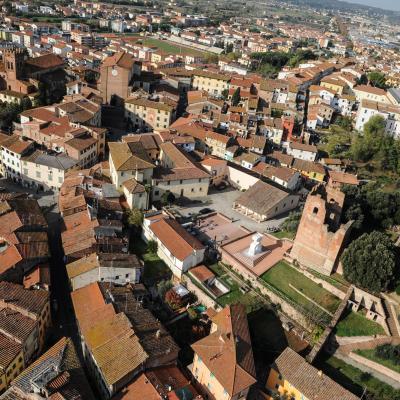I'm looking for a Franciscan friar, news about him, who lived in the time of Savonarola, and I come across - surprised - in three jockeys from Fucecchio. Figures that emerged from the nineteenth century, from Fucecchio managed to land in Piazza del Campo, Siena, to run the Palio.
I first meet Antonio Guaschi (not Guasqui). Born in Fucecchio in the (alleged) year 1827. At the age of twenty, exactly on August 16, 1847, he made his debut in Siena in the Palio del Assunta, under the battle name Folaghino, which reminds us of swampy areas. An extraordinary debut. He won with the Nicchio Contrada horse. He stood still in 1848, like everyone else. His career was missed due to the first War of Independence. It's the year of Curtatone and Montanara. In July 1849, there are three Palios: July, August and October. The extraordinary one - in October - is dedicated to the inauguration of the Empoli-Siena railway line. Folaghino is not successful in any of the three. But he won, in 1850, the one of July 2 for the Snail and it is repeated, on August 16, again for the Chiocciola (Snail). The following year he was again first in the Palio of August 17 for the Onda (Wave). Then he disappears with pretty good honours. Four Palios won over seven races. The reason for his disappearance is unknown. No news came from Siena either. And the legend goes to a loose rein. An injury, a disease, but also different choices. Certainly, not age.
The longest the participant, in the Palio di Siena is the second jockey I meet: Gonga. Pietro Montanelli, born in Fucecchio in all probability in 1834. Eleven Palios raced and no wins. He made his debut (at an advanced age) in the Palio of July 1874 with the Contrada Chiocciola (Snail). In August, he defends the colors of the Aquila (Eagle). In July 1875 he was with the Pantera (Panther). A year later, also in July, with the Drago (Dragon), and, in August, with the Civetta (Owl). In August 1877 he was with the Bruco (Caterpillar). The following year, in August, with the Aquila (Eagle). In July and August 1879, he is with the Tartufa (Truffle). The following year, in July, with the Aquila (Eagle). It closed in July 1881 with the Bruco (Caterpillar). After seven years. A presence in Piazza del Campo without the satisfaction of victory.
The third jockey, born in 1838, makes a fleeting appearance at the 1858 Assumption (August) Palio in the colors of the Istrice (Porcupine). Named Santi Soldaini, called Volpe (Fox). Who knows what drives him away from Piazza del Campo.
These three jockeys send us back to Fucecchio, who in the nineteenth century organized, for the important religious festivals, Palios to be run in Dante Street. And that he was raising jockeys who could then have the opportunity to assert themselves elsewhere, to get as far as Siena. It is also Fucecchio, land of mares and the annual livestock fair, where the horse was the master. Three names - Folaghino, Gonga, Fox - that can find a place in the imagination of those who (and are the most) love the Palio, also part of our history.
Taken from: Riccardo Cardellicchio, People and Places, The Tyrrhenian







